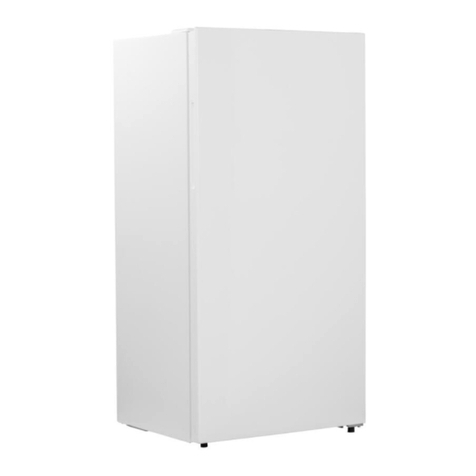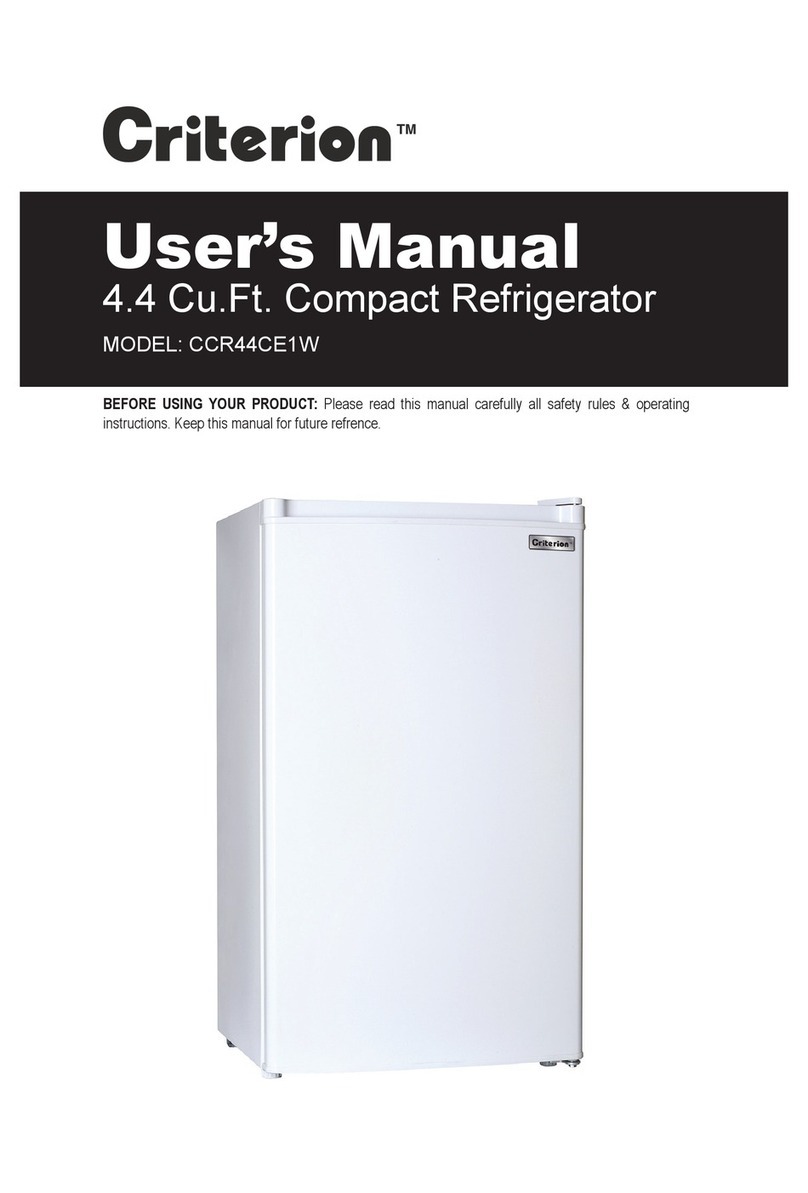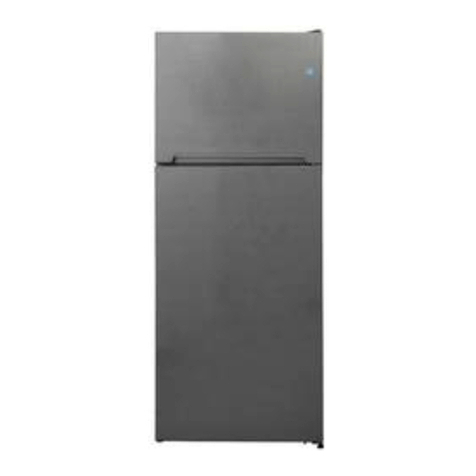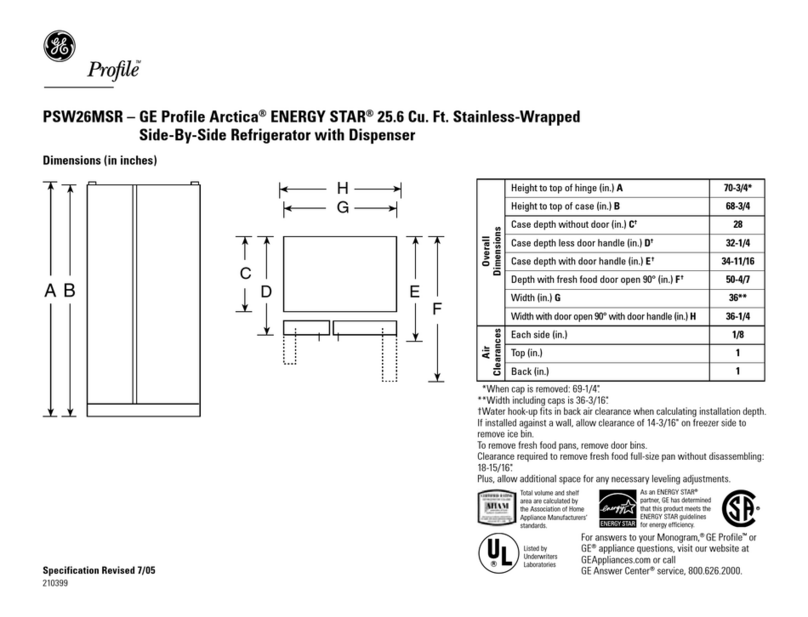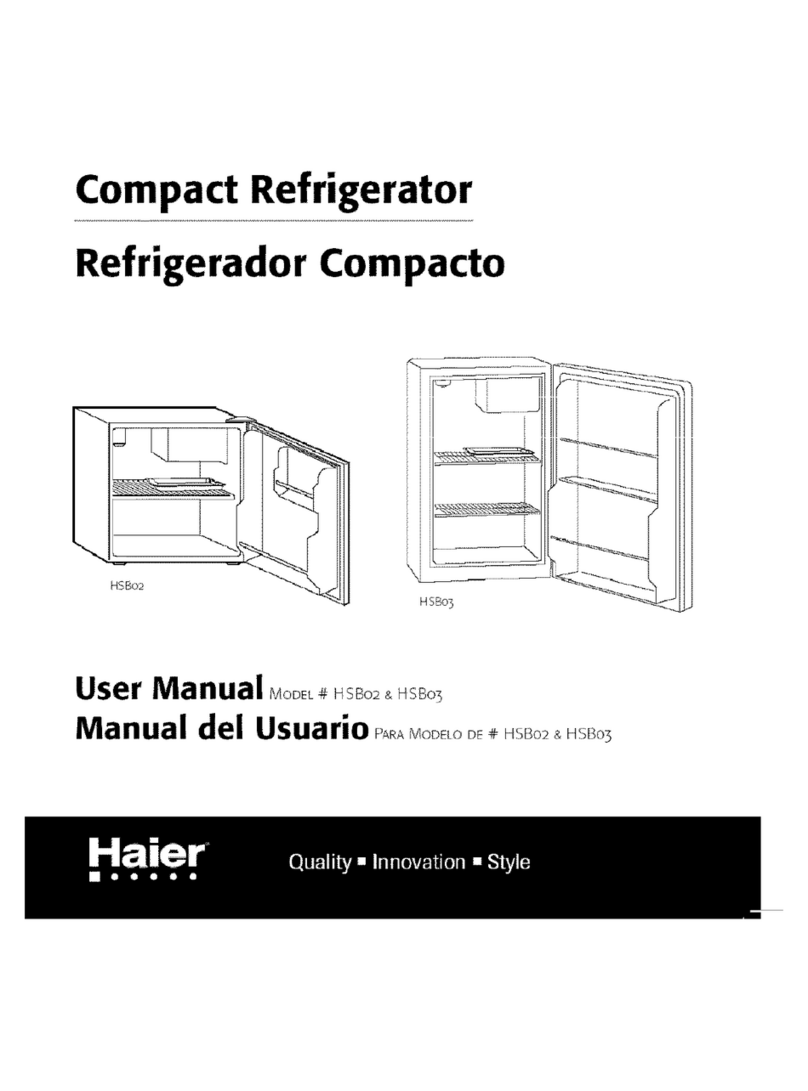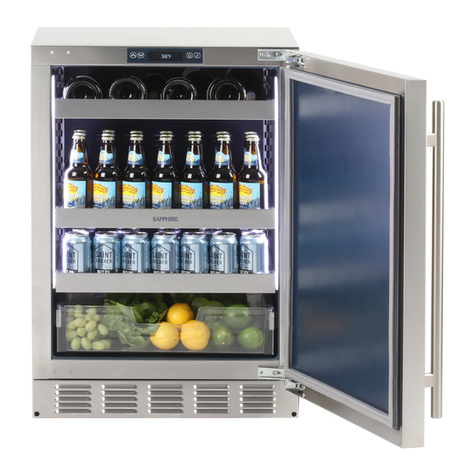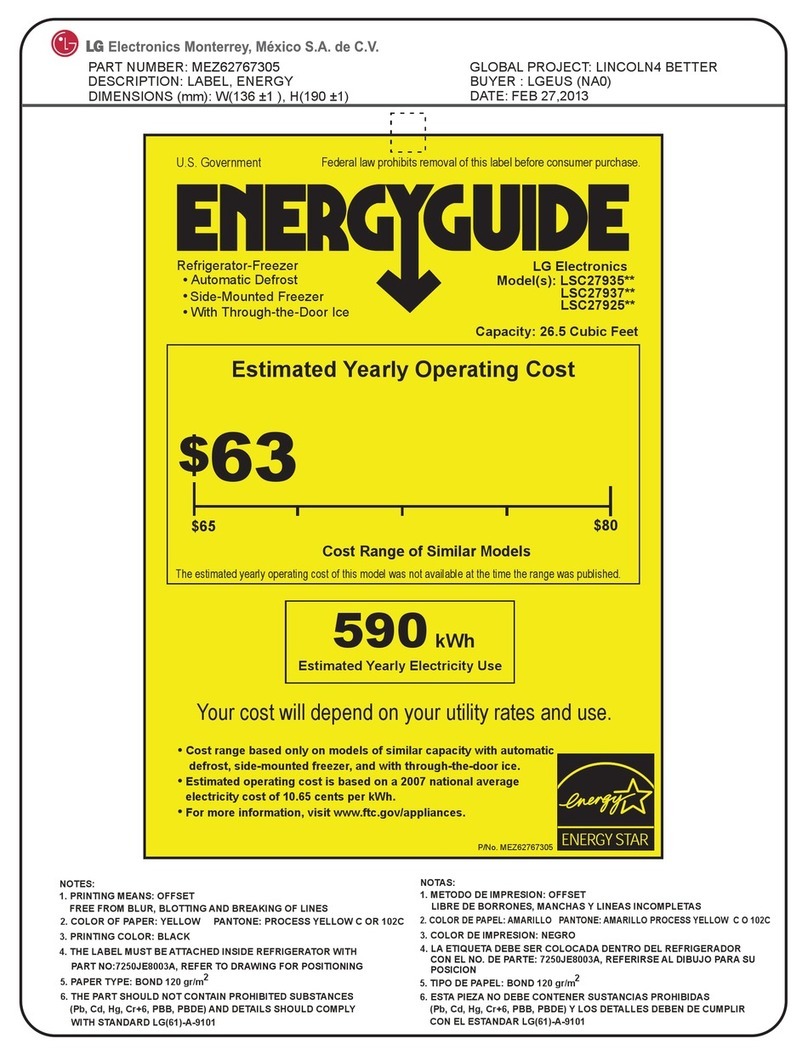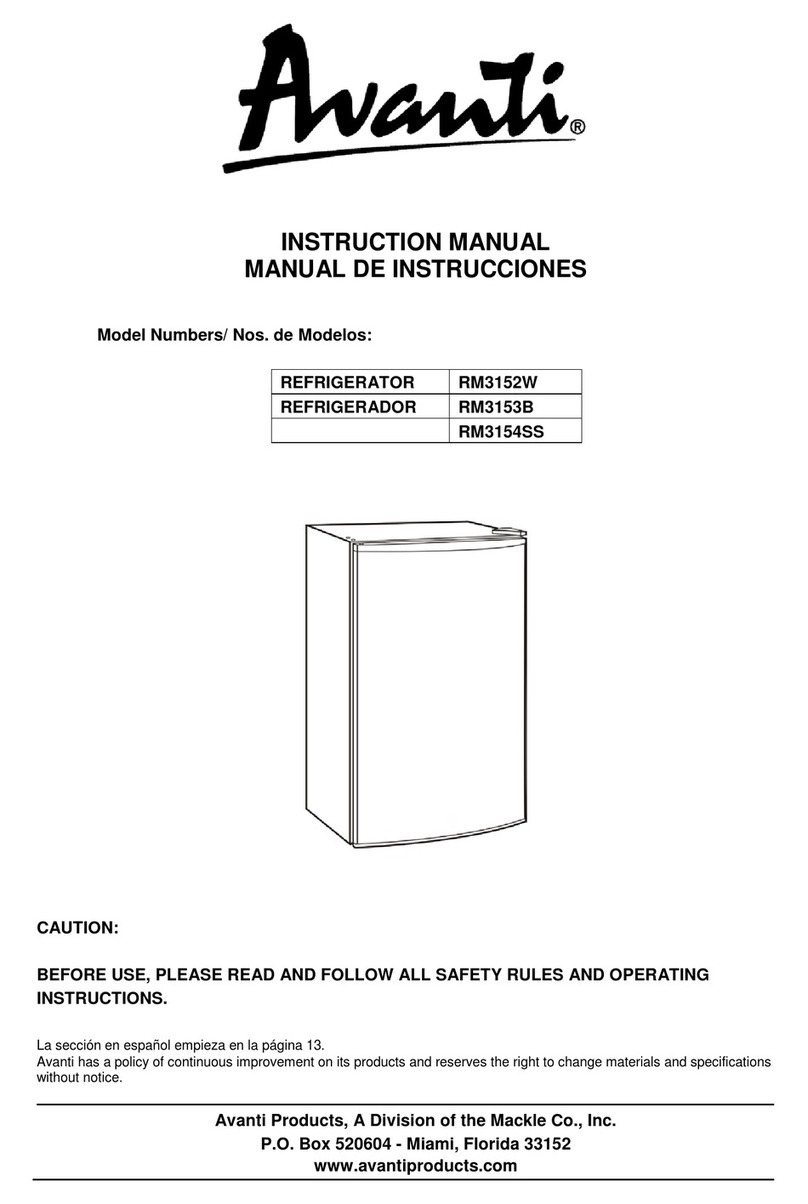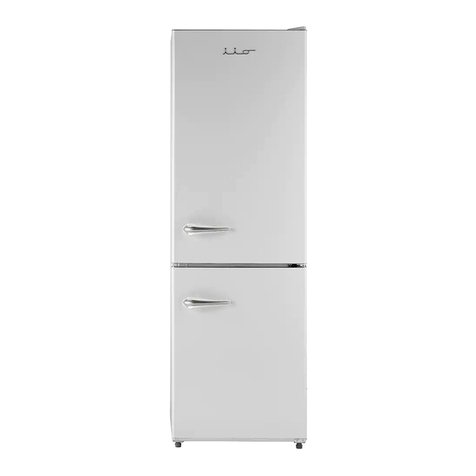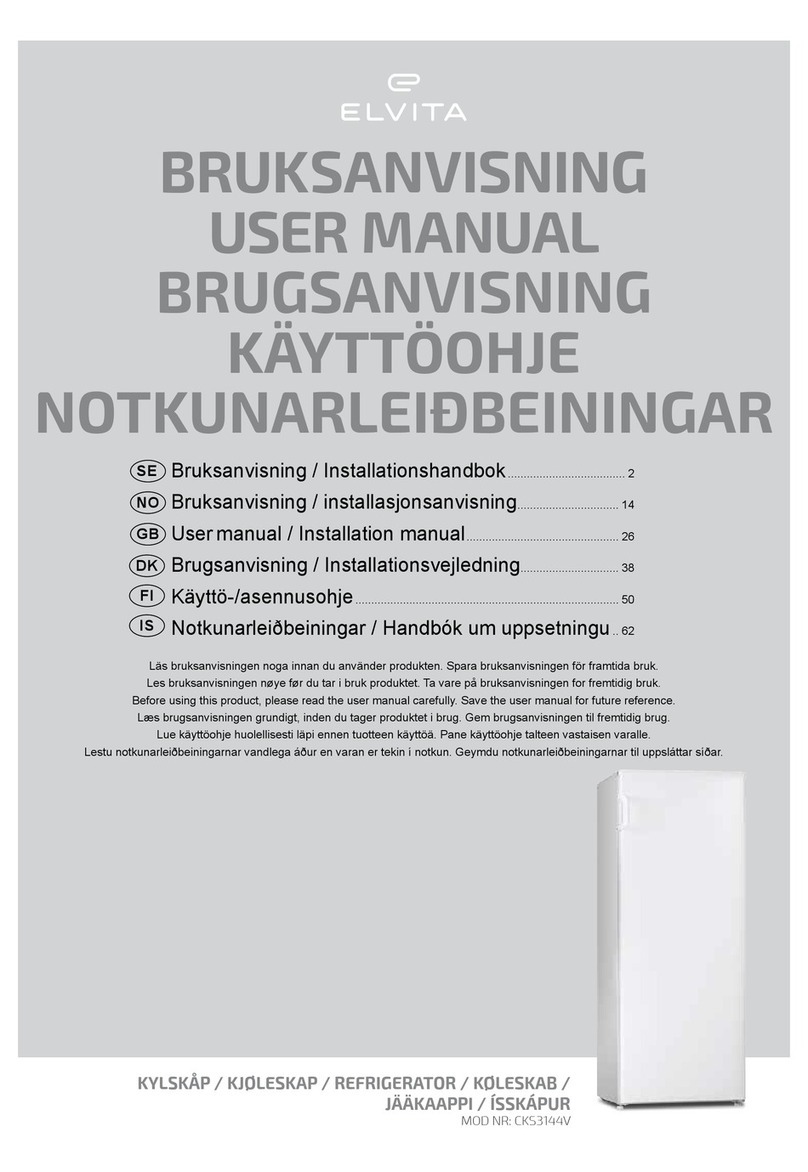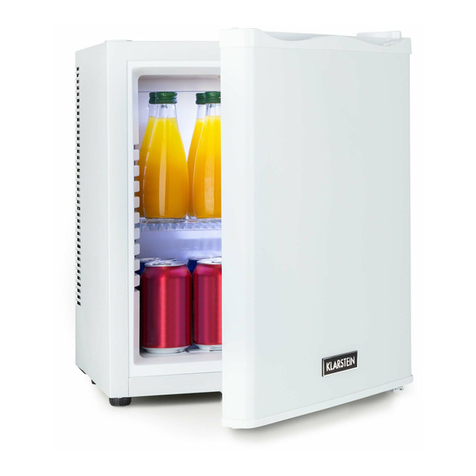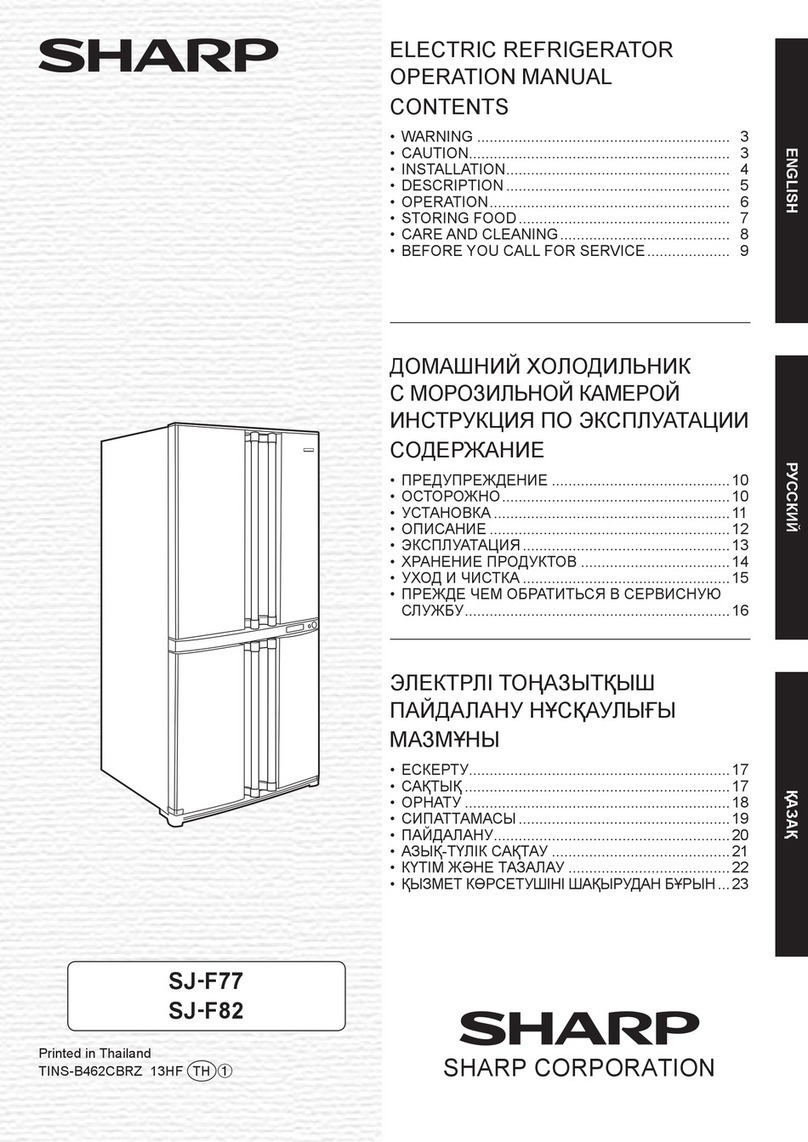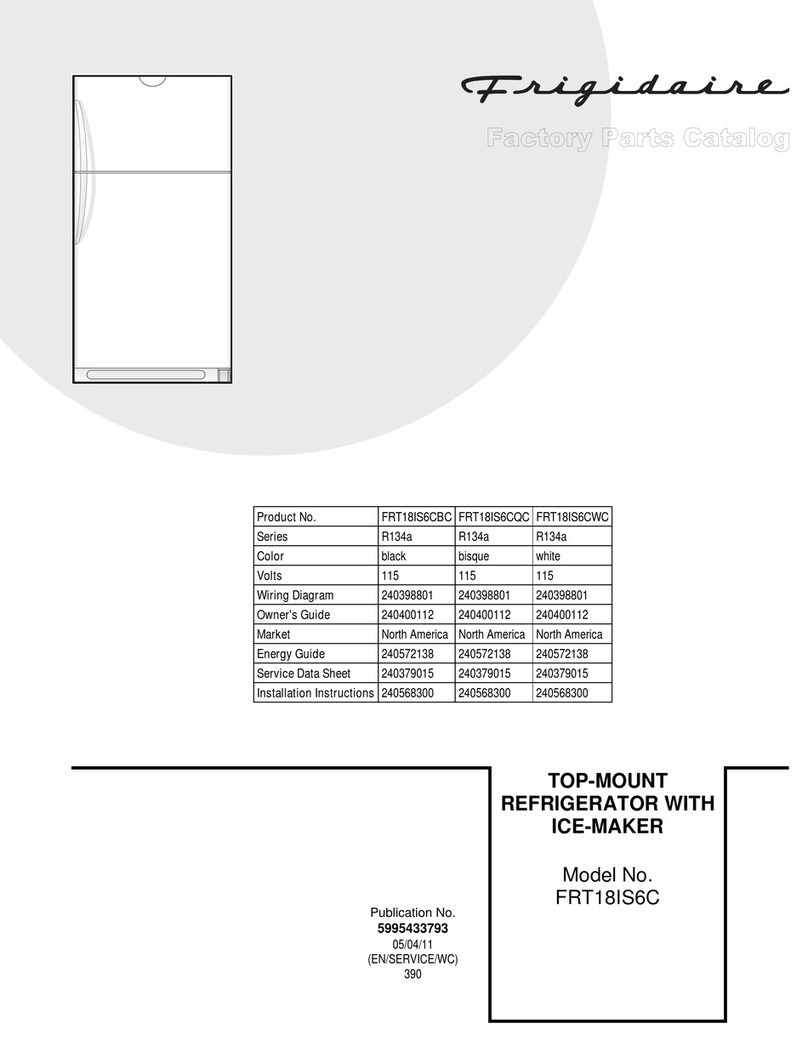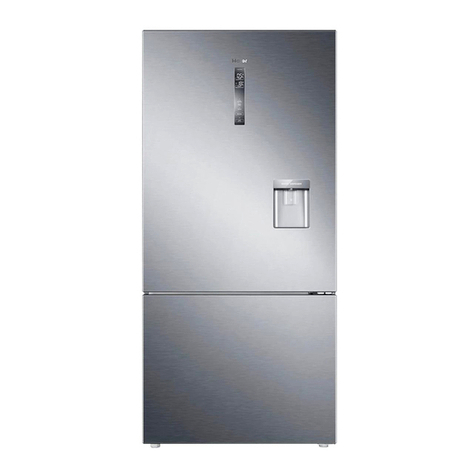Criterion CFRR310WD Series User manual

CFRR310WD#*#
User
Guide
Manual
Criterion®
Code: F86MW-01-V1

2
Important Safety Instructions
..............................
3-6
Parts and
Features...................................................
7
Refrigerator
Installation
.....................................
8-16
Unpacking Your Refrigerator
.......................................
8
Prior to
Use
...................................................................
9
Installation
.....................................................................
9
Removing/Replacing Your Refrigerator
and Freezer Handles,
Doors and Drawers
.............................................
10-
15
Refrigerator Leveling & Door Adjustment
...............
16
Using Your
Refrigerator
......................................17-
26
Setting the Controls
...................................................
17
Control Panel
..............................................................
18
Pantry Control Panel
.................................................
19
Dispenser Control Panel.
..........................................
19
lcemaker
.................................................................
20-
22
Food Storage Guide
..................................................
23
Storing Frozen Food
..................................................
23
Refrigerator Section
..............................................
24-
26
Connecting the Water Line................................... 27
Water Filter............................................................. 28
Care and
Cleaning
..............................................
29-
30
Troubleshooting Guide.....................................
31-
38
Service
.....................................................
Back Cover

SAVE THESE INSTRUCTIONS
3
BASIC
SAFETY PRECAUTIONS
This guide contains many important safety messages. Always
read and obey
all safety messages.
This is the safety alert symbol. It alerts you to safety messages that inform you of hazards that can kill or hurt
you or others, or cause damage to the product.
All safety messages will be preceded by the safety alert symbol and the hazard signal word DANGER,
WARNING or CAUTION. These words mean:
You
will
be killed or seriously injured if you do not follow instructions.
You
can
be killed or seriously injured if you do not follow instructions.
Indicates an imminently hazardous situation which, if not avoided,
may
result inminor or moderate injury, or product damage.
All safety messages will identify the hazard, tell you how to reduce the chance of injury, and tell you what can happen if the
instructions are not followed.
To reduce the risk of fire, electric shock, or personal
injury when using your product, basic safety precautions
should be followed, including the following.
Read all instructions before using this appliance.
•NEVER unplug your refrigerator by pulling on the power
cord.Always grip the plug firmly and pull it straight out from
the outlet.
•Ifthe supply cord is damaged, it must be replaced by the
manufacturer or its service agent or a similarly qualified
person in order to avoid a hazard. Do not use a cord that
shows cracks or abrasion damage along its length or at
either the plug or connector end.
•Do not modify or extend the power cord length. It could
cause electric shock or fire.
•When moving your refrigerator away from the wall, be
careful not to roll over or damage the power cord.
•DO NOT store or use gasoline or other flammable vapors
and liquids in the vicinity of this or any other appliance.
•This appliance is not intended for use by persons (including
children) with reduced physical, sensory or mental
capabilities, or lack of experience and knowledge, unless
they have been given supervision orinstruction concerning
use of the appliance by a person responsible for their
safety.
•DO NOT allow children to climb, stand, or hang on the
refrigerator doors or shelves inthe refrigerator. They could
damage the refrigerator and seriously injure themselves.
•Keep fingers out of pinch point areas; clearances between
the doors and cabinets are necessarily small. Be careful
closing doors when children are in the area.
•Unplug your refrigerator before cleaning or making any
repairs.
NOTE:
It is strongly recommended that any service be
performed by a qualified technician.
•Keep ventilation openings, in the appliance enclosure or in
the built-in structure, clear of obstruction.
•Do not use mechanical devices or other means to
accelerate the defrosting process, other than those
recommended by the manufacturer
•Do not damage the refrigerant circuit
•Do not use electrical appliances inside the food storage
compartments of the appliance unless they are ofthe type
recommended by the manufacturer
•Connect to potable water supply only.

SAVE THESE INSTRUCTIONS
4
•Before replacing a burned-out or broken light bulb, unplug
the refrigerator or turn off power at the circuit breaker or
fuse box inorder to avoid contact with a live wire filament.
(A burned-out light bulb may break when being replaced
exposing the wire filament.)
NOTE:
Some models have LED interior lighting and
service should be performed by a qualified technician.
WARNING:
Setting either or both controls to the OFF
position does not remove power to the light circuit.
•When you are finished, reconnect the refrigerator to the
electrical source and reset the controls (Thermostat,
Refrigerator Control, and or Freezer Control, depending on
the model) to the desired setting.
•This refrigerator must be properly installed inaccordance
with the Attention Installer Instructions.
•After your refrigerator is in operation, do not touch the cold
surfaces in the freezer compartment when hands are damp
or wet. Skin may adhere to the extremely cold surfaces.
•Do not plug several appliances into the same wall outlet.
- It can be a cause of overheating and/or fire. Use an
exclusive grounding receptacle for the refrigerator.
•Never hold the power cord or plug with wet hands. - There
is a risk of electric shock
•Never use a damaged power cord or plug, or loose main
socket. - There is a risk of fire, electric shock or serious
injury.
•Besure to ground. Check if your wall outlet is grounded
(earthed). - There is a risk of electric shock hazards.
•Do not install the refrigerator on a wet floor or in a place
with excessive humidity and moisture. -Electric insulation
gets weakened, resulting in a risk of electric shock
hazards.
•Never let the power cord touch or pass over heating
appliances. - Power cord can be damaged, resulting in a
risk of electric shock hazards.
•Make sure plug is fully inserted into socket to prevent the
risk of electrical shock.
•Do Not store or use gasoline or other flammable vapors
and liquids in the vicinity of this or any other appliance.
•Never pour or spray water into the refrigerator (both interior
and exterior). - Electric insulation gets weakened, resulting
in a risk of electric shock hazards.
•Do not place containers with water or liquid on top of
refrigerator. - Water can spill into the refrigerator and can
cause electric shock hazards or damage.
•Do not move or remove compartment shelves/pockets
while foods and containers are onthem. - Hard containers
(of glass, metal etc.) can fall to hurt you and can break
glass shelf and interior parts.
•Never repair, disassemble or alter the refrigerator on your
own. - There is a risk of personal injury or damage to the
refrigerator. It is recommended that any service be carried
out by a qualified person.
•If a gas leak is found near the refrigerator or in the kitchen,
ventilate it immediately without touching the power plug or
refrigerator.
•Do not store medicine, academic research samples which
require strict temperature control in the refrigerator.
•Never insert fingers or hands into the bottom of the
refrigerator, especially into the bottom back. - You can be
hurt by sharp metal edges or can receive an electric shock.
•When you find the power cord damaged or cut, call the
service agent immediately.
•When you get rid of your old refrigerator, be sure to remove
the door packings first. - Children can be entrapped and
suffocated in an abandoned refrigerator.
•Itisrecommended to unplug the refrigerator when it is not
going to be used for a long period of time.
•Never touch foods and containers especially of metal with
wet hands in the freezer compartment. - You can be hurt
by chilblains or cold burns.
•Never eat any decayed or deteriorated food at all. - Foods
stored too long in the refrigerator can deteriorate and
become decayed.
•Never place bottles andcontainers of glass inthe freezer
compartment. - Glass containers and bottles can break
and hurt you.
•When moving the refrigerator (horizontally or tilted), more
than 2 persons are required to hold it.(One to hold top back
handles,the other to hold the bottom holder). If other parts
are held instead, it is very dangerous and likely to slip.

5
•Be sure to turn up the wheel first before moving the
refrigerator - Be sure to turn up the wheel first before
moving the refrigerator, Otherwise, the parts can collide
and break each other.
•DO NOT touch the automatic ice making mechanism while
the refrigerator is plugged in.
•DO NOT refreeze frozen foods which have thawed
completely. The United States Department of Agriculture in
Home and Garden Bulletin No. 69 says:
...You may safely refreeze frozen foods that have thawed if
they still contain ice crystals or if they are still cold-below
39°F (4°C).
...Thawed ground meats, poultry or fish that have any off-odor
or off-color should not be refrozen and should not be eaten.
Thawed ice cream should be discarded. If the odor or color of
any food is poor or questionable, dispose of it. The food may
be dangerous to eat.
Even partial thawing and refreezing reduces the eating quality
of foods, particularly fruits, vegetables and prepared foods.
The eating quality of red meats is affected less than that of
many other foods. Use refrozen foods as soon as possible to
save as much of their quality as you can.
SAVE THESE INSTRUCTIONS
Junked or abandoned refrigerators are dangerous, even if they are sitting for only a few days. If you are getting rid of your old
refrigerator, please follow the instructions below to help prevent accidents (child entrapment and suffocation).
BEFORE YOU THROW AWAY
YOUR OLD REFRIGERATOR
OR FREEZER:
•Take off the doors.
•
Leave the shelves in place so that
childrenmaynot easily climb inside.
A WARNING :The use of this appliance can expose you to chemicals known to the state of California to
cause cancer, birth defects, or other reproductive harm. For more information go to www.
P65Warnings.ca.gov

6
Your old refrigerator may have a cooling system that used CFCs
or HCFCs (chlorofluorocarbons or hydrochlorofluorocarbons).
CFCs and HCFCs are believed to harm stratospheric ozone if
released to the atmosphere. Other refrigerants may also cause
harm to the environment if released to the atmosphere
If you are throwing away your old refrigerator, make sure
IMPORTANT: Please read carefully.
TO CONNECT ELECTRICITY
the refrigerant is removed for proper disposal by a qualified
technician. If you intentionally release
refrigerant, you may be subject to fines and imprisonment
under provisions of environmental legislation.
USE OF EXTENSION CORDS
Because of potential safety hazards under certain
conditions, the use of an extension cord is not
recommended.
However, ifyou still elect to use an extension
cord, it is absolutely necessary that it be a UL- listed (USA),
3-wire grounding type appliance extension cord having a
grounding type plug and outlet, and that the electrical rating of
the cord be 15 amperes (minimum) and 120 volts.
Useof an extension cord will increase the clearance needed
for the back of the refrigerator.
RECOMMENDED GROUNDING METHOD
The refrigerator should always be plugged into its own
individual properly grounded electrical outlet rated for 115
Volts, 60 Hz, AC only, and fused at 15 or 20 amperes. This
provides the best performance and also prevents overloading
house wiring circuits which could cause a fire hazard from
overheated wires. It is recommended that a separate circuit
serving only this appliance be provided.
Use a receptacle that cannot be turned off with a switch
or pull chain. Do not use an extension cord.
Where a standard two-prong wall outlet is encountered, it is
your personal responsibility and obligation to have it replaced
with a properly grounded three-prong wall outlet.
3-prong
grounding type
wall receptacle
3-prong
grounding
plug ►
J
Ensur
ground exists
before use.
Electrical Shock Hazard
FOR PERSONAL SAFETY,
this appliance must be properly
grounded. Have the wall outlet and the circuit checked by
a qualified electrician to make sure the outlet is properly
grounded.

7
17
❻
❽
❼
OPEN
CLOS
E
❸
❺
SLIM ICE MAKER
❾
❾
10
11
❹
12
12
❹
TEMPERATURE
CON
1
TR
O
3
LLED
PANTRY DRAWER
16
14
15
❹
❷
❷
❶
18
1.
Covered Dairy Bin or Covered Storage Bin
for storing butter and cheese.
2.
Gallon door storage bin
for items of medium to large size.
3.
Multi storage bin or Covered Storage Bin
for storing butter and cheese.
4.
Narrow door storage bin
for small items.
5.
lcemaker/lce cube bin
for making and holding ice for through-the-door dispenser.
6.
Air filter
7.
Water filter
8.
Narrow Top Shelf
9.
Adjustable glass shelf
10.
Slide-in Shelf
11.
Wide Slide-out Shelf
12.
Humidity controlled crisper bin
for storage of fruits and vegetables
13.
Temperature controlled full width pantry drawer
for storage of meat and fresh vegetables
14.
Pull out freezer drawer
15.
Lower freezer basket for general freezer storage
16.
Freezer Ice Storage Bin
17.
Control and display panel
18.
Ice/Water
Dispenser

8
UNPACKING YOUR REFRIGERATOR
Remove tape and anytemporary labels from your refrigerator
before using. Do not remove any warning- type labels, the
model and serial number label, or
the Tech Sheet that is located under the front of the refrigerator.
To remove any remaining tape or glue, rub the area briskly
with your thumb. Tape or glue residue can also be easily
removed by rubbing a small amount of liquid dish soap over
the adhesive with your fingers. Wipe with warm water and dry.
Do not use sharp instruments, rubbing alcohol, flammable
fluids, or abrasive cleaners to remove tape or glue. These
products can damage the surface of your refrigerator.
Refrigerator shelves are installed in the shipping position.
Please reinstall shelves according toyour individual storage
needs.
Remove all cantilevered refrigerator compartment shelves and
remove the protective shipping tape found on the attachment
hooks at back of shelves. For shelf removal instructions, see
Refrigerator Shelves in USING YOUR REFRIGERATOR
section of this Use & Care Guide.
Excessive Weight Hazard:
Use two or more people to move and install the refrigerator.
Failure to do so can result in back or other injury.
Excessive Weight Hazard:
Your refrigerator is heavy. When moving the refrigerator for
cleaning or service, be sure to protect the floor. Always pull
the refrigerator straight out when moving it. Do not wiggle or
walk the refrigerator when trying tomove it, as floor damage
could occur.
Explosion Hazard:
Keep flammable materials and vapors, such as gasoline,
away from the refrigerator. Failure to do so can result infire,
explosion, or death.

9
PRIOR TO USE
1.
Clean your refrigerator thoroughly and wipe off all dust that
accumulated during shipping.
2.
Install accessories such as ice cube bin, drawers, shelves,
etc., in their proper places. They are packed together to
prevent possible damage during shipment.
3.
Allow your refrigerator to run for at least two to three
hours before putting food in it. Check the flow of cold air
inthe freezer compartment to ensure proper cooling. Your
refrigerator is now ready for use.
INSTALLATION
The refrigerator should always be plugged into its own
individual properly grounded electrical outlet rated for 115
Volts, 60 Hz, AC only, and fused at 15 or 20 amperes. This
provides the best performance and also prevents overloading
house wiring circuits which could cause a fire hazard from
overheated wires. It is recommended that a separate circuit
serving only this appliance be provided.
INSTALLATION
(continued)
1.
To avoid noise and vibration, the unit must be leveled and
installed on a solidly constructed floor. If required, adjust
the leveling legs to compensate for unevenness of the
floor. The front should be slightly higher than the rear to
aid in door closing. Leveling legs can be turned easily by
tipping the cabinet slightly. Turn the leveling legs to the left
to raise the unit or to the right tolower it. (See Leveling and
door Alignment.)
NOTE:
Installing on carpeting, soft tile surfaces, a platform
or weakly supported structure is not recommended.
2.
Install this appliance in an area where the temperature is
between 55°F (13°C) and 110°F (43°C). If the temperature
around the appliance is too low or high, cooling ability may
be adversely affected.
3.
Select a place where a water supply can be easily
connected for the automatic icemaker.
NOTE:
The water pressure must be from 30 to 125 psi
or 207-862 kPa or 2.1-8.8 kgf/cm
2.
If the refrigerator is
installed inan area with low water pressure below 30 psi,
you can install a booster pump to compensate for the low
pressure.
4.
For sufficient door opening clearance, allow at least 4
inches between the side of the refrigerator and an adjacent
wall or surface that extends fully to or past the front door of
the refrigerator. For complete door opening, allow at least
14.8 inches between the side of refrigerator and a wall or
surface that extends to or past refrigerator front door.
5.
Too small of a distance from adjacent surfaces may result
in lowered freezing capability and increased electricity
consumption charges. Provide the following unobstructed
clearance for sufficient air flow around the refrigerator:
-At least 2 inches between refrigerator back and wall.
-At least 2 inches between refrigerator top and overhead
surface.
Shock Hazard:
To reduce the risk of electric shock, do not install the
refrigerator in a wet or damp area.

10
NOTE:
Removing the doors is always recommended
when it is necessary to move the refrigerator through a
narrow opening. If it is necessary to remove the handles,
follow the directions below.
HOW TO REMOVE REFRIGERATOR
DOOR HANDLE
NOTE:
Handle appearance may vary from the illustrations
on this page.
Removing Refrigerator Handle
Use the provided 2.5 mm hex key to loosen the set
screw located on the inside top ends of the handle.
Then pull the handle up or down slightly.
Remove the handle from the underlying handle
mounting bolts on the door.
HOW TO REPLACE REFRIGERATOR
DOOR HANDLE
NOTE:
Handle appearance may vary from the illustrations
on this page.
Replacing Refrigerator Handle
Hang the handle of one side on the mounting bolt and
push as shown. Use the 2.5 mm hex key to tighten the
set screw to secure the handle in place.
Mounting
bolt

11
NOTE:
Removing the doors is always recommended when it is necessary to move the refrigerator through a narrow opening.
If it is necessary to remove the handles, follow the directions below.
HOW TO REMOVE FREEZER
DRAWER HANDLES
NOTE:
Handle appearance may vary from the illustrations
on this page.
Use the provided 2.5 mm hex key to loosen the set
screw located onthe inside ends of the handle. Then
pull the handle sideways.
Remove the handle from the underlying handle
mounting bolts on the door.
HOW TO REPLACE FREEZER
DRAWER HANDLES
NOTE:
Handle appearance may vary from the illustrations
on this page.
Hang the handle of one side on the mounting bolt and
push as shown. Use the 2.5 mm hex key to tighten the
set screw to secure the handle in place.
A
WARNING
When assembling or disassembling the handles:
•
Grasp the handle firmly to ensure it will not drop or cause
injury.
•
Prevent the handle from swinging toward nearby people or
animals.
•
Insert the handle footprints over the door mounting
fasteners and tighten the hex screws to fix the handle in
place.
•
Check for any gap between the door and handle after the
handle is fixed in place.

12
REMOVING AND REPLACING
REFRIGERATOR DOORS
To remove the left refrigerator door:
1.
Remove top hinge cover using a phillips screwdriver by
removing 5 screws.
2.
Remove the hinge grounding wire screw and pull the
two grounding wire connections away from the hinge.
Disconnect the two wire harnesses and the water tube.
Push in the small first ring on the connection collar to
remove the tube.
4.
Lift the door from the middle hinge pin and remove the
door. Place the door, inside facing up,on a non-scratch
surface.
NOTE
:
If necessary to be able to move the unit through
a narrow door or hallway, remove the left and right door
middle hinges. Use a 10mm wrench to loosen and remove
the two bolts attaching the hinge to the cabinet.
To remove the right refrigerator door:
1.
Remove top hinge cover using a phillips screwdriver by
removing 5 screws.
2.
Using a 10 mm box end or socket wrench, turn top hinge
fastener counterclockwise to remove the top hinge plate.
Disconnect the wire harness.
CAUTION:
After the hinge is removed, the door can fall
down forward. Hold the door to prevent it from falling.
3.
Using a 10mm box end or socket wrench, turn top hinge
fastener counterclockwise to remove the top hinge plate.
CAUTION:
After the hinge is removed, the door can fall
down forward. Hold the door to prevent it from falling.
3.
Lift the door from the middle hinge pin and remove the
door. Place the door, inside facing up, on a non-scratch
surface.
Risk of electric shock!
Before removing top hinge cover
•
Shut off the water supply to the appliance.
•
Unplug the appliance or switch off power from the
breaker or fuse panel.
fl)
[]
I
r
'
.
i
'i'
.
i
,.. l
'i'
t
i
'
'i'
r
-'-
'
'
[]
i
.
'
.
i i
,.. l
'i'
r
'i'
t
i
'i'
r
-
'
'
-
'
0
0

13
0
Reinstalling the Left Refrigerator Door
1.
Lower the door onto the middle hinge.
Reinstalling the Right Refrigerator Door
1.
Lower the door onto the middle hinge.
2.
Fit the top hinge over the mounting holes and align to
proper position before tightening.
Use a 10 mm box end or socket wrench to turn top hinge
fastener to secure the hinge.
3.
Screw top hinge cover into place with a screwdriver.
2.
Fit the top hinge over the mounting holes and align to
proper position before tightening. Use a 10 mm box end
or socket wrench toturn top hinge clockwise to secure the
hinge. Securely reconnect the wire harness.
3.
Screw top hinge cover into place with a screwdriver.
[l r ]
'
rr
-
'
'
-
'
[J
-'-'
rr r
'
'
'
.l.
l
r
'
[
r
i

14
HOW TO REMOVE THE FREEZER DRAWER
A
WARNING:
Use two or more people toremove and install
the freezer drawer. Failure to do so can result in personal
injury, product or property damage.
1.
Take out the ice bin first, and then take out the upper
freezer drawer by lifting it up.
2.
Remove lower freezer basket by pulling up and tilting
toward refrigerator until itcan be removed from the freezer
drawer/door assembly.
3.
Push down on the rail locking tabs while pulling the freezer
drawer outwards to release the inner rail tracks from the
cabinet. With the aid of an assistant, continue to pull the
drawer outwards until the inner and outer rail tracks are
fully extended and the drawer is completely removed from
the cabinet.
4.
Pull exterior freezer drawer to fully disengage the rail
assembly from the unit. Use 2 people for this task as the
door is heavy and awkward to handle.
A
CAUTION:
Do not hold the handle when removing or
le may come off and it
5.
Place the door ona non-scratch surface.
llf
could cause personal
inju
.
ry.
.
replacing the drawer. The hand
..

15
HOW TO INSTALL THE FREEZER DRAWER
1.
Retract the inner rail track fully into the outer rail track
before installing freezer drawer. With the aid of an
assistant, align the rail ends with the rail guides located on
the sides of the cabinet.
Make sure that the gear teeth are engaged tothe rail
guides the same amount on both sides.
2.
Fully push in and close freezer drawer to engage rails with
rail support locking tab, applying a bit of pressure after the
door is closed to seat the tabs to the rail.
CAUTION:
Make sure the tabs are completely engaged
to the rail or the refrigerator drawer could be pulled out of
the refrigerator by the user. Fully open the freezer door to
check and see if the locking tabs are fully engaged. If they
are not engaged, gently push each freezer rail with a flat
head screwdriver towards the freezer compartment until
the locking tabs snap to the locked position.
3.
Replace the lower freezer drawer basket.
4.
Insert the upper freezer drawer above the lower basket.
5.
Open and close the freezer drawer several times to make
sure operation is smooth and seal is consistent all the way
around the freezer compartment.
CAUTION:
Do not hold the handle when removing or
replacing the drawer. The handle may come off and could
cause personal injury.

16
_J
REFRIGERATOR LEVELING
& DOOR ADJUSTMENT
The refrigerator must belevel in order tomaintain optimal
performance and desirable front appearance.
{If the floor beneath the refrigerator is uneven, the freezer and
refrigerator doors look unbalanced.)
Leveling Refrigerator
1.
Pull open the freezer compartment and remove the upper
drawer and lower drawer basket to gain access.
2.
Using the wrench provided, turn the leveling leg clockwise
to lower and counterclockwise to raise the front corners of
the refrigerator.
3.
Install the lower drawer basket and upper drawer, then
open and close the freezer compartment several times to
make sure operation is smooth and without hindrance.
Adjusting a refrigerator door
Ifthe height isuneven, use the wrench provided to turn the screw
nut on the middle hinge to adjust the refrigerator door.
1.
To raise a refrigerator door turn the screw
counterclockwise.
2.
To lower a refrigerator door turn the screw clockwise.
Adjusting the freezer drawer
If the freezer drawer is lower on one side than the other,
perform the steps listed below toraise that side. To access
the adjustment components, first pull the drawer out to full
extension.then remove the pullout drawer and the freezer
basket.
1.
Loosen the four screws on the rail bracket onthe side
where adjustment is needed.
2.
Unscrew and remove Stopper from the lower position
(left picture) and screw Stopper into the upper position (right
picture). The stopper will serve as a fixed edge against
which to turn the Position Knob to adjust the height of the
rail bracket.
3.
Slightly pull the Position Knob forward and firmly rotate it to
a different position, then release the knob back into place.
The knob surfaces push against the edge of the stopper
ring to vary the height of the rail bracket. The maximum
adjustment variance is approximately 1/8 inch.
Note:
If the Stopper does not jut out far enough to make
contact with the Position Knob, insert one or two flat
washers beneath the Stopper
4.
Retighten the four rail bracket screws.
5.
Reinsert the freezer basket and pullout drawer.
When inserting the basket, make sure that the tabs at the
front of the basket fit into the slots on the freezer drawer
rails.
rn-
r
.
+
..
-
•
[!]tt
rn

Push the FREEZERTEMPbutton and the temperature setting changes
in the sequence as shown below:
To
activate
freezer
QUICK
FREEZE,
press
and
hold
the
FREEZER TEMP button for 3 seconds. QUICK FREEZE LED will turn
on. Press the button again to cancel.
The QUICK FREEZE function is useful to help quickly freeze the
freezer compartment when needed. For example: If a
large quantity of warm food is placed inside the freezer,
or if loading the freezer with new groceries wich may
not be as cold as normal freezer temperatures.
QUICK FREEZE will automatically cancel (QUICK FREEZE LED
will turn off) after 50 hours.
Press the FRIDGE TEMP button and the temperatura setting
changes in the sequence as shown below:
To activate refrigerator QUICK CHILL, press and hold the
FRIDGE TEMP button for 3 seconds. QUICK CHILL LED will
turn on. Press the button again to cancel.
The QUICK CHILL function is useful to help quickly cool
the refrigerator compartment when needed. For example:
If a large quantity of warm food is placed inside the
refrigerator, or if loading the refrigerator with new
groceries wich may not be as cold as normal refrigerator
temperatures.
QUICK CHILL refrigerator function will automatically cancel
(QUICK CHILL LED will turn off) after 6 hours.
Push and hold CONTROL LOCK button for 3 seconds to
lock control panel. The lock icon will appear on the
dispenser panel on the left refrigerator door.
While pressing and holding the WATER FILTER and
DISPENSER DISPLAY buttons, press the FRIDGETEMP
button 5 times. Continue to press and hold the WATER
FILTER and DISPENSER LIGHT buttons for 5 more
seconds to start Demo Mode sequence and disable
cooling functions.
While pressing and holding the WATER FILTER and
DISPENSER DISPLAY buttons, press the FRIDGE TEMP
button 5 times to stop Demo Mode sequence and enable
cooling functions.
Push and hold CONTROL LOCK button for 3 seconds to
unlock control panel. The Lock icon will disappear.

When the WATER FILTER CHANGE icon turns on, you need to change
the water filter.
After changing the water filter, press and hold the WATER FILTER
button for three seconds to turn the indicator light off. You need
to change the water filter approximately every six months
Press to turn the ICE MAKER on or off. (On is default setting.)
Press and hold the ICE MAKER button for 3 seconds to turn the
QUICK ICE on.
With
DISPENSER
DISPLAY
button
off
and
one
dispenser
icon
Selection button for freezer compartment temperature.
Press and hold the FREEZER TEMP button for 3 seconds
to turn the QUICK FREEZE mode on.
Selection button for FRIDGE TEMP compartment
temperature.
Press and hold the FRIDGE TEMP button for 3
seconds to turn the QUICK CHILL mode on.
alarm
will
always
be
functional.
Presing
the
DOOR ALARM
for
more
than
60
seconds,
the
DOOR ALARM
button
LED
Pressing the DOOR ALARM button or closing the door or
drawer
will
turn
the
tone
off.
Pressing
the
DOOR ALARM
Press and
hold
the
CONTROL LOCK button
for
3
seconds
to
When
the
AIR
FILTER
CHANGE
icon
turns
on,
you
need
to
change
After changing the air filter, press and hold AIR FILTER
You
need
to
change
the
air
filter
approximately
every
six
1.
Press and hold the CONTROL LOCK button for 3 seconds
2.
Press and hold FREEZER TEMP and FRIDGE TEMP
function,
press
and
hold
CONTROL
LOCK
for
3
seconds
to

Press the SELECT button and the Temperature setting changes
Press and hold the LOCK button for 3 seconds to turn the
The LOCK icon turns on
Press and hold the LOCK button for 3 seconds to turn the
See page 26 for additional Pantry use information.
Touch the WATER, CUBED ICE or CRUSHED ICE text according to
your needs.
See page 24 for additional Dispenser user information

icemaking is automatically set to on. To turn icemaking off or
on, see the instructions in shutting icemaking off
As long as icemaking is turned on in the control panel
To turn icemaker ON or OFF: Press the control panel ICE
MAKER button. ON or OFF illuminates in the control panel
display
Table of contents
Other Criterion Refrigerator manuals
